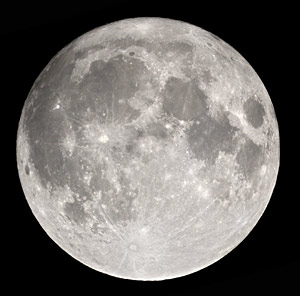
Is the July 31st full Moon, the second one this month, really a 'blue' Moon?
Courtesy Gary Seronik.
On Saturday evening, July 31st, a full Moon will rise for the second time this month (the first time was on July 2nd). Many people call the second full Moon in a calendar month a "blue Moon" and use the expression "once in a blue Moon" to mean something that occurs only rarely. While the latter meaning can be traced back centuries, the former definition is much newer — and it's wrong!
It is rare to have two full Moons in a single month. The reason is simple: the average time between full Moons is 29½ days. Thus February, with at most 29 days, can never accommodate two full Moons. To squeeze a pair into a month with 30 days, the first must occur on the 1st of the month. Months with 31 days, including July, can have two full Moons only if the first one occurs by the 2nd of the month, as happens in July 2004. The last time a calendar month included two full Moons was November 2001. Not until May 2007 (in North American time zones) or June 2007 (Europe) will it happen again.
If you want to tell friends that Saturday's full Moon is a blue Moon, go right ahead. Countless newspapers, radio and TV stations, and Web sites will certainly do so. But be aware that, technically, every one of these reports will be in error! According to Canadian folklorist Philip Hiscock, the term "blue Moon" has been around for more than 400 years, but its modern calendrical meaning has become widespread only in the last 25. And as discovered five years ago, it can be traced to a mistake published in Sky & Telescope in the 1940s!
Sky & Telescope admitted to its "blue Moon blooper," an error that had crept onto the magazine's pages 53 years earlier, in its May 1999 issue. Hiscock and Texas astronomer Donald W. Olson helped the magazine's editors figure out how the 1946 mistake was made, and how the erroneous meaning of blue Moon (as the second full Moon in a month) eventually spread around the world. Before 1946, a blue Moon always meant something else.
S&T writer James Hugh Pruett (1886–1955) made an incorrect assumption in 1946 about how the term had been used in the Maine Farmers' Almanac, where it consistently referred to the third full Moon in a three-month season containing four. (By this definition there is no blue Moon in July 2004, and the next one happens in August 2005.)
There's no turning back now. The concepts of a blue Moon as the second full Moon in a month and the third full Moon in a season containing four are listed as definitions 1a and 1b, respectively, in the American Heritage Dictionary (Houghton Mifflin Co., 4th edition, 2000).
 0
0
Comments
You must be logged in to post a comment.